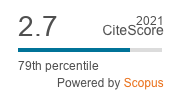A comprehensive extended SEIR model for hMPV transmission: Integrating co-infection and vaccination dynamics for Türkiye’s model
Keywords:
Human metapneumovirus (hMPV), Mathematical Modeling, Finite difference MethodAbstract
Human metapneumovirus (hMPV) is a common respiratory virus that represents a major public health burden, especially in children, older adults, and immunocompromised patients. However, traditional compartmental models, which apply to single-pathogen transmission, do not always adequately characterize the complexity of co-infections and vaccination dynamics. Here, we extend a SEIR model with two more compartments: one for those coinfected with hMPV, one for those infected with respiratory viruses other than hMPV, and another compartment for the vaccinated. This complex frame allows a realistic representation of hMPV transmission and control interventions. As a numerical solution method, we use the finite difference method (FDM) to study the behavior of these nonlinear and coupled differential equations. This method breaks down the time evolution of each compartment and can be used to simulate disease dynamics under different public health intervention schemes, such as vaccination rates. Simulation shows that intensive vaccination would significantly decrease the peak of infections and expedite the epidemic's control, especially together with non-pharmaceutical interventions. The co-infection compartment shows how the simultaneous presence of overlapping infections can exacerbate the severity of an epidemic, emphasizing the need for combined control strategies. Our model is a useful tool for understanding hMPV epidemic in the presence of other pathogens, which helps estimate the efficacy of vaccination strategies. This biologically motivated model, coupled with a strong numerical solution, provides important information for health authorities in their quest to minimize the effects of the disease.
References
Williams, J., Shafagati, N. (2018). Human metapneumovirus – what we know now. F1000Research, 7, 135. https://doi.org/10.12688/F1000RESEARCH.12625.1
Santus, P., et al. (2024). Burden and risk factors for coinfections in patients with a viral respiratory tract infection. Pathogens, 13(11), 993. https://doi.org/10.3390/PATHOGENS13110993/S1
Keeling, M. J., Rohani, P. (2008). Modeling infectious diseases through contact networks. Princeton University Press, p. 385.
Keeling, M. J., Rohani, P. (2011). Modeling infectious diseases in humans and animals. Princeton University Press, pp. 1–368. https://doi.org/10.1016/s1473-3099(08)70147-6
Miller, R. J., Mousa, J. J. (2023). Structural basis for respiratory syncytial virus and human metapneumovirus neutralization. Current Opinion in Virology, 61, 101337. https://doi.org/10.1016/J.COVIRO.2023.101337
Baker, R. E., et al. (2021). Infectious disease in an era of global change. Nature Reviews Microbiology, 20(4), 193–205. https://doi.org/10.1038/s41579-021-00639-z
Pragathi, P., Shetty, U., Parida, P., Varamballi, P., Mukhopadhyay, C., Sudheesh, N. (2024). Molecular detection and genotyping of HMPV in patients with severe acute respiratory infection in India. Annals of Medicine, 56(1). https://doi.org/10.1080/07853890.2024.2398719
Noffel, Z., Dobrovolny, H. M. (2024). Modeling the bystander effect during viral coinfection. Journal of Theoretical Biology, 594, 111928. https://doi.org/10.1016/J.JTBI.2024.111928
Devanathan, N., et al. (2025). Emerging lineages A2.2.1 and A2.2.2 of human metapneumovirus (hMPV) in pediatric respiratory infections: Insights from India. IJID Regions, 14, 100486. https://doi.org/10.1016/J.IJREGI.2024.100486
Zhu, R., et al. (2020). Epidemiological and genetic characteristics of human metapneumovirus in pediatric patients across six consecutive seasons in Beijing, China. International Journal of Infectious Diseases, 91, 137–142. https://doi.org/10.1016/J.IJID.2019.11.012
Pidjadee, C., Soh, K. L., Attharos, T., Soh, K. G. (2024). The effect of infection prevention and control programme for childcare workers in daycare centres: A systematic review. Journal of Pediatric Nursing, 79, 116–125. https://doi.org/10.1016/j.pedn.2024.09.002
Mendes Neto, A. G., et al. (2021). Bacterial infections and patterns of antibiotic use in patients with COVID-19. Journal of Medical Virology, 93(3), 1489–1495. https://doi.org/10.1002/JMV.26441
Nardo, D., Maddox, E. G., Riley, J. L. (2025). Cell therapies for viral diseases: A new frontier. Seminars in Immunopathology, 47(1), 1–8. https://doi.org/10.1007/S00281-024-01031-8
Motta, C. M., Keller, M. D., Bollard, C. M. (2023). Applications of virus-specific T cell therapies post-BMT. Seminars in Hematology, 60(1), 10–19. https://doi.org/10.1053/J.SEMINHEMATOL.2022.12.002
Feltes, T. F., et al. (2003). Palivizumab prophylaxis reduces hospitalization due to respiratory syncytial virus in young children with hemodynamically significant congenital heart disease. Journal of Pediatrics, 143(4), 532–540. https://doi.org/10.1067/S0022-3476(03)00454-2
Enver, A., Ayaz, F. (2025). Mathematical modeling of stress induced type 2 diabetes and atherosclerosis: Numerical methods and stability analysis. Results in Nonlinear Analysis, 8(1), 204–225. https://doi.org/10.31838/rna/2025.08.01.019
Nabti, A., Djilali, S., Bentout, S. (2025). Stability and spatial profiles of a double age-dependent diffusive viral infection model with spatial heterogeneity. Zeitschrift fur angewandte Mathematik und Physik, 76, 89. https://doi.org/10.1007/s00033-025-02087-6
Bentout, S., Djilali, S. (2024). Asymptotic profiles of a generalized reaction-diffusion SIS epidemic model with spatial heterogeneity. Zeitschrift fur angewandte Mathematik und Physik, 75, 225. https://doi.org/10.1007/s00033-024-02025-3
Djilali, S., Sarmad, G., Tridane, A. (2025). Dynamics and asymptotic profiles of a local-nonlocal dispersal SIR epidemic model with spatial heterogeneity. Infectious Disease Modelling, 10(2), 387–409. https://doi.org/10.1016/j.idm.2025.03.007
Djilali, S., Chen, Y., Zou, S. (2025). A diffusive SIS epidemic model in a heterogeneous environment: Random dispersion vs. nonlocal dispersion. Mathematics and Computers in Simulation, 236, 90–110. https://doi.org/10.1016/j.matcom.2025.06.004
Enver, A., Ayaz, F., Yalcinkaya, D. E. (2025). A multiscale coupled reaction-diffusion model of amyloid-beta and tau pathology in Alzheimer’s disease. Journal of Nonlinear Modeling and Analysis, 7(5), 1940–1964. https://doi.org/10.12150/jnma.2025.1940
Downloads
Published
How to Cite
Issue
Section
License
Copyright (c) 2025 Results in Nonlinear Analysis

This work is licensed under a Creative Commons Attribution 4.0 International License.



